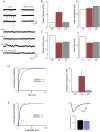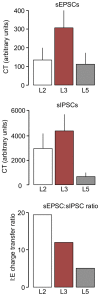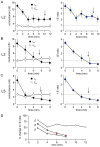Background synaptic activity in rat entorhinal cortex shows a progressively greater dominance of inhibition over excitation from deep to superficial layers
- PMID: 24454801
- PMCID: PMC3893176
- DOI: 10.1371/journal.pone.0085125
Background synaptic activity in rat entorhinal cortex shows a progressively greater dominance of inhibition over excitation from deep to superficial layers
Abstract
The entorhinal cortex (EC) controls hippocampal input and output, playing major roles in memory and spatial navigation. Different layers of the EC subserve different functions and a number of studies have compared properties of neurones across layers. We have studied synaptic inhibition and excitation in EC neurones, and we have previously compared spontaneous synaptic release of glutamate and GABA using patch clamp recordings of synaptic currents in principal neurones of layers II (L2) and V (L5). Here, we add comparative studies in layer III (L3). Such studies essentially look at neuronal activity from a presynaptic viewpoint. To correlate this with the postsynaptic consequences of spontaneous transmitter release, we have determined global postsynaptic conductances mediated by the two transmitters, using a method to estimate conductances from membrane potential fluctuations. We have previously presented some of this data for L3 and now extend to L2 and L5. Inhibition dominates excitation in all layers but the ratio follows a clear rank order (highest to lowest) of L2>L3>L5. The variance of the background conductances was markedly higher for excitation and inhibition in L2 compared to L3 or L5. We also show that induction of synchronized network epileptiform activity by blockade of GABA inhibition reveals a relative reluctance of L2 to participate in such activity. This was associated with maintenance of a dominant background inhibition in L2, whereas in L3 and L5 the absolute level of inhibition fell below that of excitation, coincident with the appearance of synchronized discharges. Further experiments identified potential roles for competition for bicuculline by ambient GABA at the GABAA receptor, and strychnine-sensitive glycine receptors in residual inhibition in L2. We discuss our results in terms of control of excitability in neuronal subpopulations of EC neurones and what these may suggest for their functional roles.
Conflict of interest statement
Figures








Similar articles
-
Simultaneous estimation of global background synaptic inhibition and excitation from membrane potential fluctuations in layer III neurons of the rat entorhinal cortex in vitro.Neuroscience. 2007 Jul 29;147(4):884-92. doi: 10.1016/j.neuroscience.2007.05.016. Epub 2007 Jun 28. Neuroscience. 2007. PMID: 17600630 Free PMC article.
-
Pre- and post-synaptic functions of kainate receptors at glutamate and GABA synapses in the rat entorhinal cortex.Hippocampus. 2012 Mar;22(3):555-76. doi: 10.1002/hipo.20921. Epub 2011 Mar 1. Hippocampus. 2012. PMID: 21365713
-
Depression of glutamate and GABA release by presynaptic GABAB receptors in the entorhinal cortex in normal and chronically epileptic rats.Neurosignals. 2006-2007;15(4):202-15. doi: 10.1159/000098515. Epub 2007 Jan 11. Neurosignals. 2006. PMID: 17215590 Free PMC article.
-
Activation of neurokinin-1 receptors promotes GABA release at synapses in the rat entorhinal cortex.Neuroscience. 2002;115(2):575-86. doi: 10.1016/s0306-4522(02)00412-8. Neuroscience. 2002. PMID: 12421623
-
Background synaptic activity in rat entorhinal cortical neurones: differential control of transmitter release by presynaptic receptors.J Physiol. 2005 Jan 1;562(Pt 1):107-20. doi: 10.1113/jphysiol.2004.076133. Epub 2004 Oct 21. J Physiol. 2005. PMID: 15498804 Free PMC article. Review.
Cited by
-
MicroRNAs contribute to postnatal development of laminar differences and neuronal subtypes in the rat medial entorhinal cortex.Brain Struct Funct. 2017 Sep;222(7):3107-3126. doi: 10.1007/s00429-017-1389-z. Epub 2017 Mar 4. Brain Struct Funct. 2017. PMID: 28260163 Free PMC article.
-
Microcircuits for spatial coding in the medial entorhinal cortex.Physiol Rev. 2022 Apr 1;102(2):653-688. doi: 10.1152/physrev.00042.2020. Epub 2021 Jul 13. Physiol Rev. 2022. PMID: 34254836 Free PMC article. Review.
References
-
- Eichenbaum H (2001) The long and winding road to memory consolidation. Nat Neurosci 4: 1057–1058. - PubMed
-
- Squire LR, Stark CE, Clark RE (2004) The medial temporal lobe. Ann Rev Neurosci 27: 279–306. - PubMed
-
- Witter MP, Moser EI (2006) Spatial representation and the architecture of the entorhinal cortex. Trends Neurosci 29: 671–678. - PubMed
Publication types
MeSH terms
Substances
Grants and funding
LinkOut - more resources
Full Text Sources
Other Literature Sources

